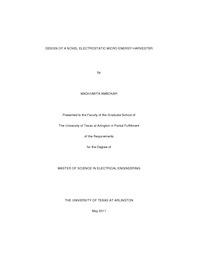
ATTENTION: The works hosted here are being migrated to a new repository that will consolidate resources, improve discoverability, and better show UTA's research impact on the global community. We will update authors as the migration progresses. Please see MavMatrix for more information.
Show simple item record
| dc.contributor.author | Ambokar, Madhumita | en_US |
| dc.date.accessioned | 2011-07-14T20:48:22Z | |
| dc.date.available | 2011-07-14T20:48:22Z | |
| dc.date.issued | 2011-07-14 | |
| dc.date.submitted | January 2011 | en_US |
| dc.identifier.other | DISS-11157 | en_US |
| dc.identifier.uri | http://hdl.handle.net/10106/5636 | |
| dc.description.abstract | The batteries have been a major source of energy for the electronic devices. However, the exhaustible nature of the batteries has encouraged the researchers to exploit the renewable energy sources for powering the electronics. Over the years, the researchers have tried to tap the stray energy provided by the ambient sources such as sun, wind, RF energy, vibration energy, etc. In the work presented here, an effort has been made to design a micro energy harvester, which would harness electric energy from the vibrations provided by the machine such as aircrafts, cars, engines, etc. A variable capacitive device was designed such that the capacitance of the device changes with the change in the overlap area between the electrodes. The electrodes of the device were modified such that one of the electrodes was designed as a hollow cubic structure while the other electrode was inserted in it in the form of a stationary cantilever beam. A train of such modules was designed to obtain high capacitance values. Three device models were proposed where the number and the dimensions of cantilever beams were varied along with the dimensions of the cubic electrodes.The devices were designed for the source acceleration of the range of 1.3 - 1.5g and the source frequency of 100 Hz. The displacement and the capacitance of the devices were determined by performing Finite Element Analysis (FEA) using the CoventorWare<sup>TM</sup> software. The capacitance values obtained from the simulations were then used to estimate the electrostatic energy that would be generated from the devices. The electrostatic energy was estimated for both charge-constrained and voltage-constrained conversion cycles. In the case of charge-constrained conversion cycle, the input voltage for the devices was assumed to be 10 V. On the other hand, in case of the voltage-constrained conversion cycle, a continuous input voltage of the 100 V was assumed to be supplied by an electrets material. The power generated was estimated by multiplying the energy with the frequency of vibrations (100 Hz). The device model number three named Model3_200CL203, was observed to be the best in terms of the amount of energy that would be generated. A volumetric power maximum of 1810 µW/cm<super>3</super> was estimated for a voltage-constrained conversion cycle, while the volumetric power of 21.64 µW/cm<super>3</super> was estimated for the charge-constrained conversion cycle.A fabrication process flow was proposed. The metal electrodes were proposed to be fabricated using the electroplating process. A eutectic bonding process was proposed for realizing the hollow cubic structure. However, a few fabrication issues, such as realization of high aspect ratios and unreliable bonding of narrow bonding sites of the width of 5 µm, were predicted. Hence, a few design modifications were suggested for all the devices so that the fabrication of the devices can be made less challenging. The effects of design modifications, on the displacement and capacitance of the devices, were also studied by simulating the modified devices in CoventorWare<sup>TM</sup>. | en_US |
| dc.description.sponsorship | Celik-Butler, Zeynep | en_US |
| dc.language.iso | en | en_US |
| dc.publisher | Electrical Engineering | en_US |
| dc.title | Design Of A Novel Electrostatic Micro Energy Harvester | en_US |
| dc.type | M.S. | en_US |
| dc.contributor.committeeChair | Celik-Butler, Zeynep | en_US |
| dc.degree.department | Electrical Engineering | en_US |
| dc.degree.discipline | Electrical Engineering | en_US |
| dc.degree.grantor | University of Texas at Arlington | en_US |
| dc.degree.level | masters | en_US |
| dc.degree.name | M.S. | en_US |
Files in this item
- Name:
- Ambokar_uta_2502M_11157.pdf
- Size:
- 6.698Mb
- Format:
- PDF
This item appears in the following Collection(s)
Show simple item record


